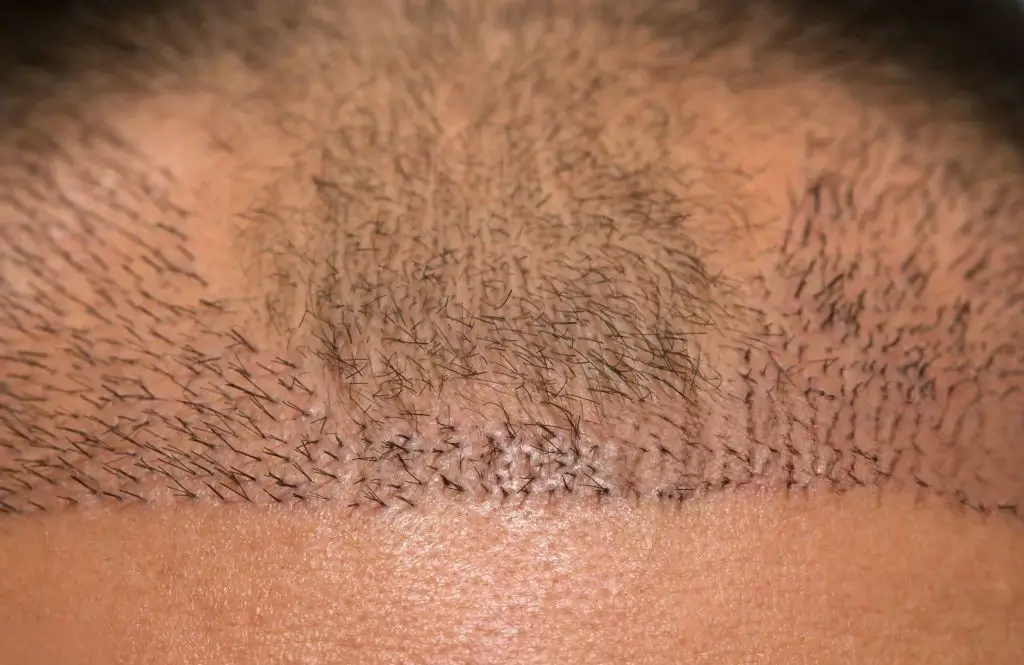Hair transplant scars are typically small and faint, and they are usually hidden by the surrounding hair. In most cases, the scars will become less noticeable over time. However, you can discuss potential treatments with your doctor if you are worried about how your scars appear. These may include scar creams or gels, steroid injections, or laser therapy. Your Surgeon will be able to recommend the best treatment option for your specific situation.
How scars can be treated
Hair transplant scars can typically be treated with a combination of medical and cosmetic techniques. The type and severity of the scar will determine the best course of action.
One option is to undergo scar revision surgery, which is a procedure that can help to minimize the appearance of scars by removing or repositioning the scar tissue. This can be performed using a range of methodologies, including skin grafting or tissue expansion.
Another option is to use topical treatments, such as silicone gels or sheets, which can help to soften and flatten the scar tissue.
In some cases, laser treatment may also be effective in reducing the appearance of hair transplant scars. Laser therapy can help to stimulate collagen production and improve the overall texture and tone of the skin.
It’s important to keep in mind that the success of these treatments can vary depending on the individual and the specific type of scar. It may be necessary to try a combination of different treatments in order to achieve the desired results.
Before pursuing any treatment for hair transplant scars, it’s crucial to speak with a trained medical expert, such as a dermatologist or cosmetic surgeon. They will be able to evaluate the scar and suggest the best course of action.

What factors are involved in hair transplant scars
There are many factors that can affect the likelihood of developing hair transplant scars, as well as the type and severity of the scars. Some of these factors include:
- The type of hair transplant procedure: Different hair transplant techniques can result in different types and patterns of scarring. For example, the “strip method” of transplanting necessitates the removal of a strip of skin from the scalp’s back, which may leave a linear scar.
- The individual’s genetics: Some people are more prone to scarring than others due to genetic factors.
- The individual’s skin type: People with darker skin tones may be more likely to develop hypertrophic scars or keloid scars, which are raised, thick scars that can be difficult to treat.
- The individual’s overall health: People who are in good health are generally more likely to heal well after a hair transplant procedure and develop minimal scarring.
- The individual’s post-operative care: Proper care after a hair transplant, including keeping the incision site clean and protected, can help to minimize scarring.
- The individual’s response to treatment: Some people may be more responsive to scar treatment than others, depending on a variety of factors.
Overall, the process of developing hair transplant scars is complicated and regulated by a variety of factors. It is important to consult with a qualified medical professional for personalized advice on how to minimize the risk of scarring and treat any scars that may develop.
Which hair transplantation procedure doesn’t result in a scar?
There is no hair transplantation procedure that does not result in scarring. All surgical procedures, including hair transplantation, involve making incisions in the skin, which will result in some degree of scarring.
However, some hair transplant techniques can result in less noticeable scarring than others. For example, the “follicular unit extraction” (FUE) method of transplantation involves removing individual hair follicles from the scalp using a specialized tool. Because this technique does not involve removing a strip of skin, it can result in less noticeable scarring.
Other techniques, such as the “strip method” of transplantation, involve removing a strip of skin from the back of the scalp, which can result in a linear scar. This scar can often be hidden by the remaining hair, but it is still visible in some cases.
Ultimately, the best technique for minimizing scarring will depend on the individual and the specific situation. It is important to consult with a qualified medical professional to determine the best approach for your needs.

